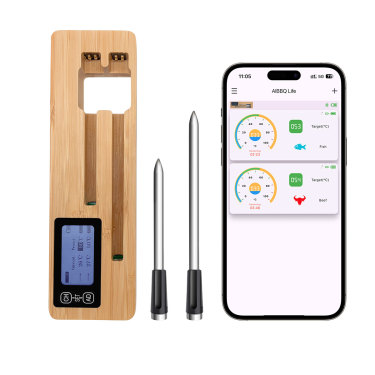
# Digital Meat Thermometer: The Essential Tool for Perfectly Cooked Meals
## Why Every Kitchen Needs a Digital Meat Thermometer
Cooking meat to the perfect temperature is both an art and a science. Whether you’re grilling steaks, roasting a turkey, or preparing a delicate salmon fillet, a digital meat thermometer is the most reliable way to ensure your food is cooked safely and to your desired doneness.
Unlike traditional analog thermometers, digital versions provide instant, accurate readings with clear digital displays. This eliminates the guesswork from cooking and helps prevent both undercooked and overcooked meals.
## Key Features to Look For
When shopping for a digital meat thermometer, consider these important features:
1. Fast and Accurate Readings
Look for models that provide temperature readings within 2-3 seconds with an accuracy of ±1°F (±0.5°C). This is particularly important when cooking delicate proteins like fish or when checking multiple pieces of meat quickly.
2. Temperature Range
A good digital meat thermometer should cover a wide range from at least 32°F (0°C) to 572°F (300°C) to handle everything from rare steaks to deep frying.
3. Probe Design
The probe should be thin enough to insert easily without damaging the meat, yet durable enough to withstand regular use. Stainless steel probes are ideal for both durability and food safety.
4. Waterproof Construction
Since cooking can be messy, a waterproof design makes cleaning easier and protects the electronics from spills and splashes.
## How to Use Your Digital Meat Thermometer Properly
Insertion Technique
For most meats, insert the probe into the thickest part, avoiding bones, fat, or gristle. For poultry, check both the breast and thigh areas. For thin cuts like burgers, insert the probe sideways through the edge.
Resting Time Considerations
Remember that meat continues to cook after removal from heat (carryover cooking). For best results, remove meat from heat when it’s 5-10°F below your target temperature, then let it rest before serving.
Cleaning and Maintenance
Always clean the probe thoroughly after each use with warm soapy water. Avoid submerging the display unit unless it’s specifically designed to be waterproof.
## Recommended Safe Cooking Temperatures
Here are the USDA recommended minimum internal temperatures for common meats:
- Beef, Pork, Veal & Lamb (steaks, chops, roasts): 145°F (63°C) with 3-minute rest
- Ground Meats: 160°F (71°C)
- Poultry (whole, parts, or ground): 165°F (74°C)
- Fish: 145°F (63°C) or until flesh is opaque
## Advanced Features Worth Considering
Some premium digital meat thermometers offer additional features that can enhance your cooking experience:
Wireless Connectivity
Bluetooth or WiFi-enabled thermometers allow you to monitor temperatures remotely via smartphone apps, perfect for smoking or slow-cooking.
Programmable Alarms
Set target temperatures and receive alerts when your food reaches the perfect doneness, preventing overcooking.
Keyword: digital meat thermometer
Multiple Probe Options
Some models support multiple probes simultaneously, allowing you to monitor different meats or different sections of large roasts at the same time.
## Making the Most of Your Investment
A quality digital meat thermometer can